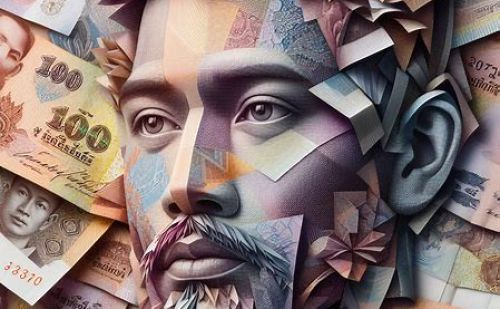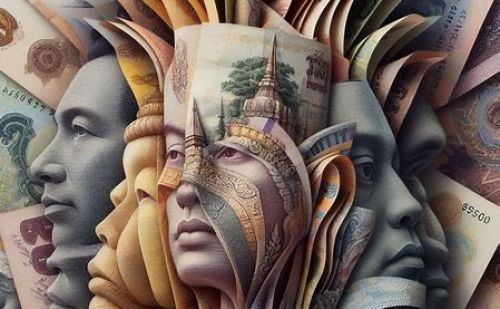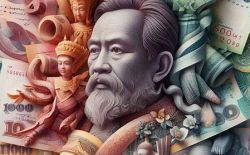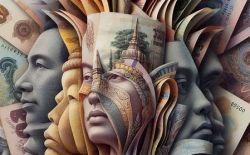Banknotes in Thailand
Banknotes in Thailand
Thailand banknotes It began to be used during the reign of King Mongkut. Paper money was used for the first time, but it was not yet called a banknote, using the word "summon" instead. It was issued in 1853 and continued to be used for a total of 3 generations during the reign of King Chulalongkorn. His Majesty the King graciously announced the use of paper tickets worth 1 att to replace the coins that were not sufficient for use. This is the origin of the word "Attha Paper" which is used colloquially among the people. Later, His Majesty allowed foreign banks to open branches to operate in Thailand, namely the Hong Kong and Shanghai Bank. Chartered Bank of India, Australia and China and Bank of Indochina To be able to issue their own banknotes, called bank notes or banknotes, were considered to be the first bank cards used in Thailand until September 7, 1902, when His Majesty the King ordered them to be canceled and officially announced the use of the first type of banknotes in Thailand. Formal
Coins
The coin is hard objects Mostly made of metal or Plastic and has the shape of a round disc. Coins are used. It has many uses, such as using it as currency with value for exchange, called coins, which are produced and distributed by the government. Coins are used as cash in the modern monetary system just like banknotes, but in lower value units. While banknotes are used in higher value units, the maximum value of a coin is usually lower than the minimum value of a banknote. The exchange value of a coin comes from its historical value and or the intrinsic value of its metal components.
Currency
Currency means any object or document. that are generally accepted in exchange for goods and services and used to pay debts in a country or company in a particular society and economy according to the law The main functions of money can be classified as: It is a medium of exchange. It is a unit of measurement of value. It is a preserver of value and sometimes the past. It is the standard for repayment of debt in advance. Any verifiable and secure object or document. which can perform these duties are all money Money was born as material money. But virtually all contemporary monetary systems are based on paper money. Paper money is devoid of any intrinsic functional value like physical goods. And the value of paper money comes from the government's declaration of it as legal tender, that is, it must be accepted as a form of exchange within the country's territory against all debts. both public and private debt
There are 16 types of Thai banknotes/h2>
Type 1 has 1 5 10 20 50 100 1000 baht It is a banknote printed on one front side
Type 2 has 1 5 10 20 100 1000 baht. Starting to print embossed lines.
Type 3 has 1 5 10 20 baht and has a portrait of King Rama VII.
Type 4 has 1 5 10 20 100 1000 baht and has started using the word Thai Government instead of the word Government of Siam.
Type 5 has 50 satang and 1 5 10 20 100 1000 baht, printed from Japan. Because it was during the Great East Asia War Therefore, printing cannot be ordered from Thomas de la Rue Company.
Type 6 has 20 100 baht printed by the Royal Thai Army Survey Department and Naval Hydrographic Department Using raw materials that can be found in the country. Because the war intensified Japan cannot transport banknotes. This set of banknotes is therefore of low quality and is widely forged. But it was able to help alleviate the shortage of banknotes throughout the war.
Type 7 has 1 5 10 50 baht, printed in Thailand. by a private printing house whose work was at a standard level at that time By separating the banknote prints, number categories, and signatures in different places. The Bank of Thailand has sent officials to closely monitor printing. But due to the end of the war, paper and printing ink were limited. The quality and color of the banknotes are therefore not as good as they should be. And because the size of the banknote was smaller than normal banknotes at that time, people sometimes called it Kanomko Bank
Type 8. There are 5 types. Price 1 5 10 20 100 baht. Printed by The Tudor Press Company from the United States. Because the Thomas de la Rue Company had been damaged by the war. No embossed lines and watermarks In those days there was a lot of counterfeiting of banknotes.
Type 9 has 50 satang and 1 5 10 20 100 baht, printed by Thomas de la Rue Company.
Type 10 has a single price of 100 baht. It has raised lines, many colors, and has a Thai pattern because there is a counterfeit. Type 9 has a price of 100 baht. A lot
Type 11 has 5 types, price 5 10 20 100 500 baht, printed in Thailand. by banknote printing house Established by the Bank of Thailand
Type 12 has 3 types, price 10 20 100 baht. On the back there is a picture of the royal monument of the great king.
Type 13 has 2 types, priced at 50 500 baht, to join in celebrating the 200th anniversary of Rattanakosin, 50 baht banknote, picture of the president on the front. Portrait of His Majesty the King in full royal robes His Majesty's robe.
Type 14 has 3 types, price 100 500 1000 baht, issued 1000 baht per issue. To respond to the use of large amounts of money Picture of the main image of the lost side of the thousand baht type. Has a royal portrait Both of them
Series 15 has a price of 20 50 100 500 1000 baht. It is the banknote that is mostly used today. At the end of the 15th series, the 50 baht banknote format was changed from polymer to plain paper to reduce costs and Prevents the material from which the banknote is made from being worth more than the value of the banknote. And the 1000 baht banknote has an additional silver stripe. To prevent counterfeiting and do not print 10 baht banknotes.
Type 16 has 20 50 100 500 1000 baht. It is a banknote currently in use. On the back there is a royal monument of the king who is the Great.
Type 17 has 5 types, price 20 50 100 500 1000 baht There is a design idea to honor every monarch.of the Chakri Dynasty who performs royal duties in every aspect to cure suffering and promote happiness Bringing tranquility to the people and the nation.








